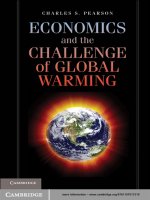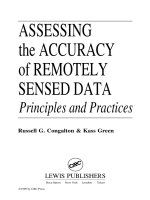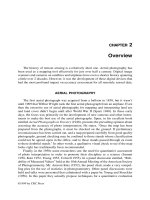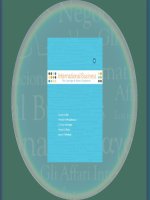International bussiness the challenge of global competition 11e chapter 03
Bạn đang xem bản rút gọn của tài liệu. Xem và tải ngay bản đầy đủ của tài liệu tại đây (300.57 KB, 35 trang )
chapter three
Theories of International Trade
and Investment
McGraw-Hill/Irwin
International Business, 11/e
Copyright © 2008 The McGraw-Hill Companies, Inc. All rights reserved.
Learning Objectives
Explain the theories that attempt to explain
why certain goods are traded internationally
Discuss the arguments for imposing trade
restrictions
Explain two basic kinds of import restrictions:
tariff and nontariff trade barriers
3-3
Learning Objectives
Appreciate the relevance of changing status of
tariff and nontariff barriers to managers
Explain some of the theories of foreign direct
investment
3-4
International Trade Theory
• Mercantilism
– Economic philosophy based on belief that
• (1) a nation’s wealth depends on accumulated
treasure, usually gold, and
• (2) to increase wealth, government policies
should promote exports and discourage imports
3-5
Theory of Absolute Advantage
• Absolute advantage
– Theory that a nation has absolute
advantage when it can produce a larger
amount of a good or service for the same
amount of inputs as can another country or
– When it can produce the same amount of a
good or service using fewer inputs than
could another country
3-6
Absolute Advantage
Example
Each Country Specializes
3-7
Absolute Advantage
Terms of Trade (Ratio of International Prices)
Gains from Specialization and Trade
3-8
Theory of Comparative Advantage
• Comparative Advantage
– A nation having absolute disadvantages in
the production of two goods with respect to
another nation has a comparative or relative
advantage in the production of the good in
which its absolute disadvantage is less
3-9
Theory of Comparative Advantage
Example
Each Country Specializes
3-10
Comparative Advantage
Terms of Trade – at a rate of ¾ bolt of cloth for 1 ton of soybeans
Terms of Trade – at a rate of 1 bolt of cloth for 1 ton of soybeans
Gains from Specialization and Trade
3-11
Comparative Advantage
• Production Possibility Frontiers (figure 3.1)
Figure
3.1
3-12
Heckscher-Ohlin Theory of Factor
Endowment
• Factor Endowment
– Heckscher-Ohlin theory that countries
export products requiring large amounts of
their abundant production factors and import
products requiring large amounts of their
scarce production factors
3-13
Heckscher-Ohlin Theory of Factor
Endowment
• Leontief Paradox
– The United States, one of the most capital-intensive
countries in the world, was exporting relatively
labor-intensive products in exchange for relatively
capital-intensive products
• Differences in Taste
– A demand-side construct that is always difficult to
deal with in economic theory
3-14
How Can Money Change The
Direction of Trade?
Example
Exchange Rate – the price of one currency stated in terms of another currency
3-15
How Can Money Change The
Direction of Trade?
• Influences of Exchange Rate
– Currency devaluation
• The lowering of a currency’s price in terms of
other currencies
3-16
Some Newer Explanations For The
Direction Of Trade
• Linder Theory of Overlapping Demand
– Customers’ tastes are strongly affected by
income levels; therefore a nation’s income
per capita level determines the kinds of
goods they will demand
3-17
Some Newer Explanations For The
Direction Of Trade
• International Product Life Cycle (IPLC)
– Explains why a product that begins as
export eventually becomes import (figure
3.2)
•
•
•
•
U.S. exports
Foreign production begins
Foreign competition in export market
Import competition in the United States
3-18
Figure 3.2 International Product Life
Cycle
3-19
Some Newer Explanations For The
Direction Of Trade
• Technology Life Cycle
– Production technology application of IPLC
• Economies of Scale and Experience Curve
– As a plant gets larger and output increase, the
average cost of producing each unit of output
decreases
– As firms produce more products, they learn ways to
improve production efficiency
3-20
Some Newer Explanations For The
Direction Of Trade
• Imperfect Competition
– Economies of scale with the existence of
differentiated products--Paul Krugman
• First-Mover Theory
– Pattern of trade in goods subject to scale
economies may be determined by historical
factors
3-21
Some Newer Explanations For The
Direction Of Trade
• National Competitive Advantage from Regional
Clusters: Porter’s Diamond Model (figure 3.3)
– National Competitiveness: a nation’s relative ability
to design, produce, distribute, or service products
while earning increasing returns on resources
• Demand conditions
• Factor Conditions
• Related and supporting industries
• Firm strategy, structure, and rivalry
3-22
Figure 3.3 Variable Impacting Competitive
Advantage: Porter’s Diamond
Source: Reprinted by permission of the Harvard Business Review. “The Competitive Advantage of Nations” by Michael E. Porter,
March–April 1990, p. 77. Copyright © 1990 by The President and Fellows of Harvard College; all rights reserved.
3-23
Trade Restrictions: Arguments For
•
•
•
•
National Defense
Sanctions to Punish Offending Nations
Protect Infant (or Dying) Industry
Protect Domestic Jobs from Cheap Foreign
Labor
• Scientific Tariff or Fair Competition
3-24
Trade Restrictions
• Retaliation
– Dumping: selling a product abroad for less
than the cost of production, the price in the
home market, or the price to third countries
•
•
•
•
•
Social dumping
Environmental dumping
Financial services dumping
Cultural dumping
Tax dumping
3-25









